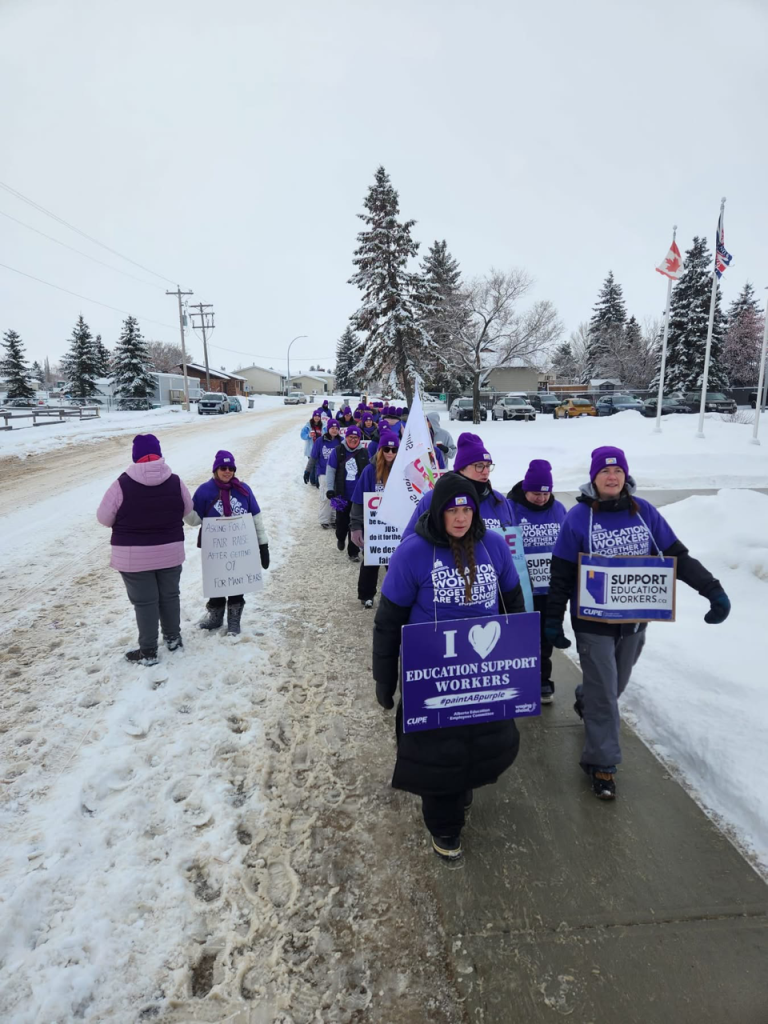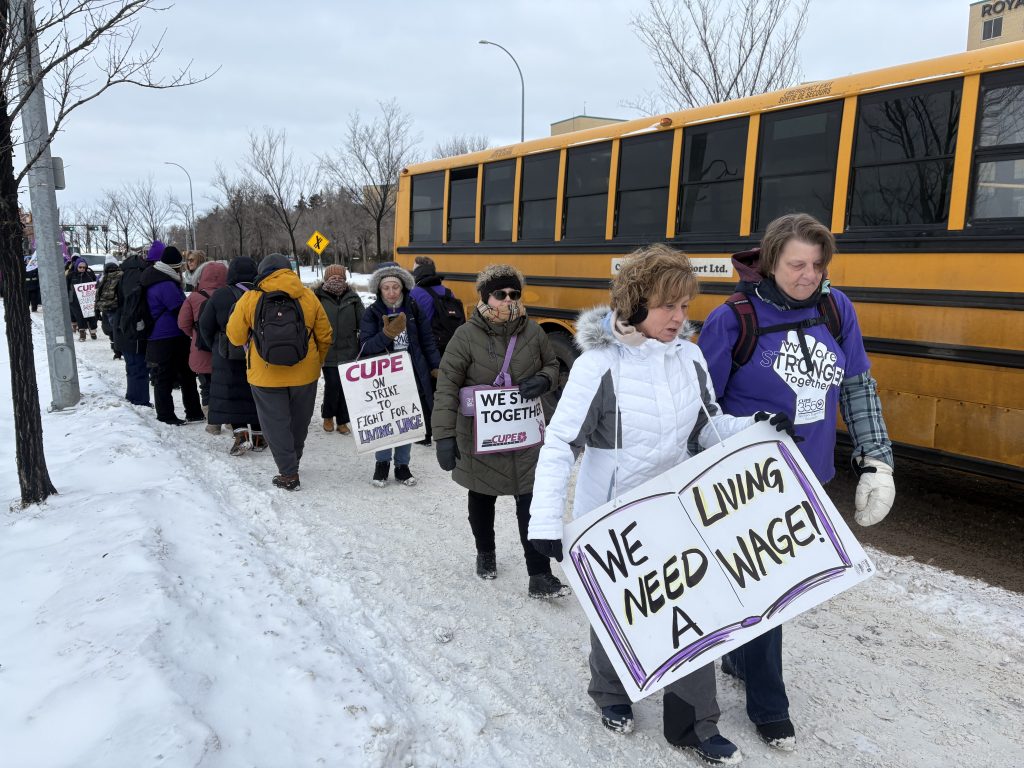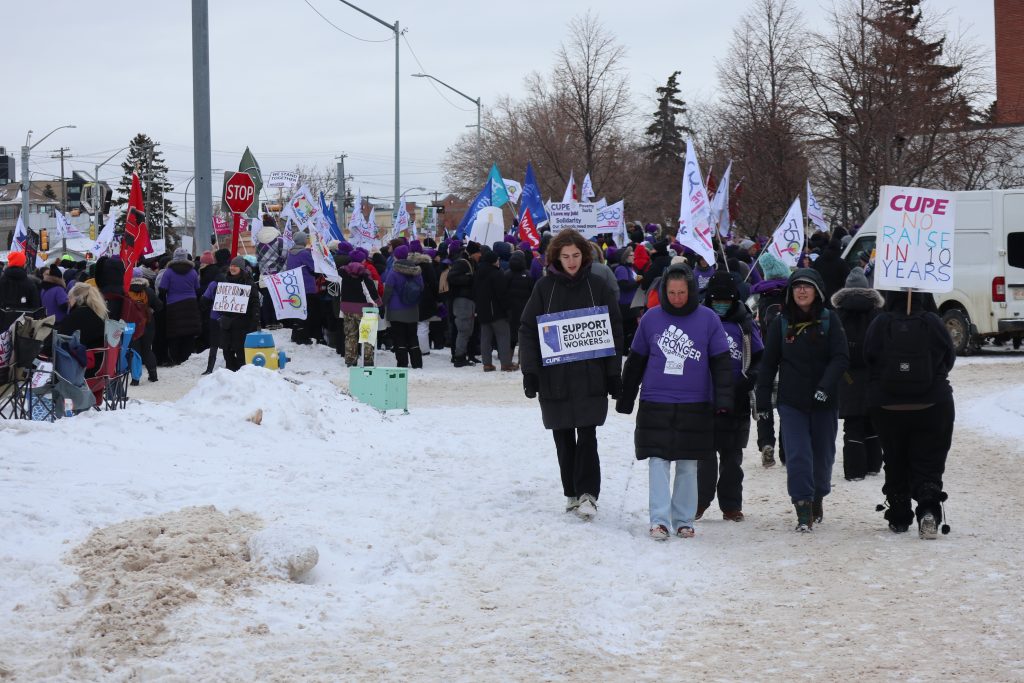International Women’s Day – March 2025



“We need a living wage!” said a sign carried on a picket line in Edmonton in January. Education support workers in various parts of Alberta, members of the Canadian Union of Public Employees (CUPE), took job action starting in the fall of 2024, with strikes expanding so that by early March 2025 approximately 6,400 education support workers were on strike, pressing for fair wages and working conditions for their very important work.
As of March 21, 2025 all the CUPE Alberta locals of education support workers that had been on strike reached agreements with the school districts. “The education workers’ strike is a testament to the value of collective action and standing up for your rights,” said newly-elected CUPE Alberta President Raj Uppal. “They walked the line for months in frigid weather, they stood up to bullying and derision, and they made the government blink. I couldn’t be more proud to be a part of the same union as them.”
The vast majority of education support workers are women and visible minorities, says Danielle Danis, an Educational Assistant (EA) and president of CUPE Local 2559 (Fort McMurray Roman Catholic Separate School Division), who is also on the CUPE Alberta Executive Board as an Area Vice President and a CUPE Member Facilitator. A significant number of the leadership positions in the locals involved are held by women. In recognition of International Women’s Day (IWD), celebrated worldwide on March 8, it is especially important to support activism to achieve fair wages and working conditions. ALHI had the opportunity to interview Danielle, along with Nicole Spring, a member of the strike committee of CUPE Local 2545 (Fort McMurray Public School Division).
Nicole is a highly qualified, experienced, and dedicated EA who works in a Grade 1 classroom in Fort McMurray that has 31 pupils. Her formal assignment through the full school day is to work with two high needs children who have qualified for “coding” under provincial requirements for extra assistance with “special needs” children. In practice, she works with seven children because there are five children in that classroom who are either autistic, highly anxious, or who have behavioural issues but who are not coded as special needs. It is challenging work, and without it the teacher would be overwhelmed in their efforts to deal with the educational and social needs of all 31 pupils. Most school days, Nicole leaves her exhausting work in the classroom to work at one of her two additional part-time jobs. Low EA pay makes moonlighting a necessity, especially as rising inflation stretches wages ever further.
Nicole believes that her circumstances are common for EAs across the province. She and many of her fellow strikers argued that the Government of Alberta, which determines funding for school boards, was oblivious to the skills and sacrifices that EAs, who are almost all women, bring to their profession. Instead, the government seemed to view them as “babysitters” and demonstrated disrespect for this group of invaluable workers by mandating low wages and by under-funding education. These workers’ wages then would be deemed unjustifiably low in any “equal pay for work of equal value analysis” – an analysis of the skills and responsibility embodied in jobs traditionally held by women or other historically undervalued groups in the labour force compared to skills and responsibility embodied in jobs traditionally filled mainly by men.
Important workApproximately one half of the education support workers involved in the job actions were EAs, with the next largest group being in clerical job positions, and with others including lunchroom monitors, custodial workers, and maintenance workers, noted a CUPE Alberta spokesperson. The work done by education support workers is profoundly important for the students, the families, the teachers, and the overall functioning of the schools. EAs provide support and access to education to children with diverse needs, and they also support teachers’ ability to carry out their roles.
Like Nicole, Danielle has worked as an EA on a one-to-one basis with students with autism, and she now works as a literacy EA in English, French, and Spanish, assisting high school students in a French immersion program and others with reading comprehension issues. Danielle has a three-year Child and Youth Care Worker diploma from Northern College in Timmins, Ontario, and a four-year Bachelor’s degree in Child and Youth Care from the University of Victoria. Nicole also has significant education for her role, with a diploma in a two-year program for Developmental Services Worker at Confederation College in Thunder Bay, Ontario, covering a range of services in the disability sector, including education. In addition, she has participated in specialized training over the years, such as with the Geneva Centre for Autism in Toronto and in professional development programs offered through school districts.
The minimum qualifications now for an EA position is a 10-month EA certificate, and many have significantly more, noted Danielle. MacEwan University in Edmonton, for example, offers an Educational Assistant certificate program requiring 10 courses, noting “The certificate provides a solid foundation of theoretical knowledge combined with practical strategies to support classroom instructional, behavioural, and social needs of diverse students.”
Poverty level wages and low funding
The average yearly wage for education support workers at the time of the strikes was only $34,500, with the average yearly wage for EAs being even lower, approximately $27,000, said Rory Gill, president of CUPE Alberta during the strikes, noting that some education support workers had “endured a 30% inflation over a decade without any wage increases.” The CUPE Alberta President had also noted that Alberta had the lowest education funding of any province in Canada.
The impact of poverty-level wages on the classroom was staggering, indicated Mandy Lamoureux, President of CUPE Local 3550 (Edmonton Public School Board). “People are quitting, no one will take the jobs at these wages, and students and education are suffering,” she said, noting that the vacancy rate for support positions at the Edmonton Public School Board was approximately 10%.
For the CUPE locals on strike, there had been no new collective agreement since 2020 or 2021. The collective agreement negotiations for these locals had been for the period 2020 or 2021 through 2024 and potentially for a period for after 2024, CUPE Alberta representatives explained.
Nicole said, “[These] are careers, and they should be careers that people can be proud to do and that they can live doing. We want to support the students in our schools. We want to support the citizens in Alberta. But to be able to do that we need to be able to support ourselves and our families. And right now, with what the government is doing to public services, people aren’t able to do that.” She added that an underlying issue was lack of respect from the government. Both Danielle and Nicole decried government comments that make it seem as if educational support is part-time work and “fluff,” but it’s not. “It’s not just babysitting services,” they added.
Government wage cap mandate
The main obstacle to coming to a fair agreement at the bargaining tables was a government-issued mandate of wage caps applying to all school divisions, noted CUPE Alberta’s then-president Rory Gill in an open letter sent to Nate Horner, President of Treasury Board and Minister of Justice. The open letter asked the government to remove the wage cap mandate and to provide the funding necessary to fulfill staffing and services. The operation of government wage mandates for the public sector is described in the Parkland Institute’s report A Thumb on the Scale: Alberta Government Interference in Public-Sector Bargaining.
The term of 5 of the agreements reached in late March is for 2024 – 2028, and for 4 of the agreements is 2020 – 2028. All 9 agreements are higher than the provincial government mandate, noted CUPE Alberta.
Both Danielle and Nicole emphasized the importance of public services. It is investing in the future, Danielle noted, adding “It’s extremely important that our tax dollars continue to go to public services. I want people’s eyes to be opened as to what is going on in this province. And for people to remember at election time that elections do matter. And to make sure that your voice is heard.” Nicole concurred, saying, “You can’t run a community or a province without public services. These are important jobs.” She added, “In this strike, we need to fight, and we need to stand up. And we need to support each other in doing that.”
Pay equity
The current low level of wages for education support workers in Alberta raises the issue of pay equity – the right based on gender to equal pay for work of equal value. According to Alberta government data, the wage gap in 2024 between women and men in Alberta was the widest among the provinces, with the average weekly female wage rate being 71% of the average weekly male wage rate.
Canada ratified in 1972 the International Labour Organization (ILO) Convention No. 100, the Equal Remuneration Convention, with the commitment to promoting and ensuring the principle of “equal remuneration for men and women workers for work of equal value.” Alberta’s legislation currently does not give full expression to this principle. The Alberta Human Rights Act provides that when “employees of both sexes perform the same or substantially similar work for an employer in an establishment, the employer shall pay the employees at the same rate of pay.” But this does not allow for comparison of different job categories based on equal value. (For Alberta workplaces in the federally regulated jurisdiction, such as banks, there is legislation providing for equal pay for work of equal value.)
The Committee of Experts of the ILO has regularly communicated to the government of Canada – most recently in 2024, noting “deep concern” – that Alberta’s legislation (along with some other provinces and territories) does not give full expression to the principle of equal remuneration for men and women for work of equal value.
The Alberta Union of Provincial Employees (AUPE) has been advocating for years for legislative commitment to equal pay for work of equal value.
Conclusion
ALHI honours the work of women in Alberta – both in the paid workforce and in unpaid work, such as caregiving to young children, to family members with disabilities, and to aging family members. The experiences, achievements, barriers, challenges, and activism of Alberta women are told through various themes on the ALHI website, and in interviews with women from various communities and various workplaces. On the themes of Alberta women and work, women in the skilled trades, and other themes in which interviews with women are included, see here.


